2022 ITG Conference Report - Day 2 - Wednesday, June 1
The 46th Annual International Trumpet Guild Conference - San Antonio, Texas (USA)
Special Daily Report • Compiled by Peter Wood
Photos by Denny Schreffler, Josh Rzepka, Benjamin Lowe, Ryan Berndt, Jeff Grass, and Michael Anderson
Wednesday, June 1, 2022
Click here for more photos from the ITG Conference
Andy Kozar warm-up session - Response: A Guide to An Easier Way of Trumpet Playing
From New York City and Boston, Andy Kozar brought a refreshing approach to the classical trumpeter’s daily warm-up routine. This routine consisted of the standard method repertoire from Vincent Cichowicz, Bai Lin, James Thompson, and Herbert L. Clarke, but with additions on each exercise. These are minor alterations that better serve the approach of playing with a balanced lip tension and air flow throughout all registers. He coached the class through six exercises that covered breath, buzzing, flow studies, and scales. Kozar will be releasing this warm-up approach in his new book, Response: A Guide to an Easier Way of Trumpet Playing, which will be released on September 1, 2022. (Maryna Pohlman)
Christopher Scanlon warm-up session - The 3 Cs: Covering Your Bases with an Integrated Routine of Caruso, Cichowicz, and Clarke
Dr. Christopher Scanlon gave practical insight into his preferred warm-up method by discussing the three Cs: Caruso, Cichowicz, and Clarke. Each of these methods play a key role in filling what he calls “buckets.” The first bucket is filled by finding a beautiful sound. This includes preliminary stretches, breathing exercises, and mouthpiece buzzing, followed by Caruso’s “Six Notes” exercise. While Scanlon does not refute the isometric value of Caruso, he factors it into his warmup as a long-tone exercise. The second bucket is that of moving throughout the entirety of the player’s range. This is where Cichowicz’s flow studies become beneficial. The final bucket consists of warming up the player’s technical facilities, in which Scanlon advocates for variations on Clarke’s Technical Studies. If done correctly, the three Cs fill these buckets, leaving the player ready for practice or performance. (Christopher Luebke-Brown)
Nairam Simoes warm-up session - Going on a Trumpet S.A.F.A.R.E.: A Warmup for Developing Efficient Practice Habits
Dr. Nairam Simoes’ warm-up session focused on the acronym S.A.F.A.R.E. (Sound, Articulation, Flexibility, Agility, Range, Endurance) as a guide for daily warmup. He used exercises familiar to trumpet players - long tones, lip slurs, and scales. To spice things up, however, rhythms from his native Brazil were utilized as a sort of metronome while playing standard exercises by Cichowicz, Clarke, Plog, and others. Some rhythms included baião, frevo, and samba. Each exercise had a different rhythm to accompany it, and Simoes gave a little history of the origin and significance of each rhythm. Simoes also discussed ways to adapt his warmup to address areas of concern, time constraints, and individual skill levels. It was a very informative and engaging session. (Kyle Millsap)
Brianne Borden session - Morning Yoga for Musicians
Participants were able to start their day with mindfulness exercises through Dr. Brianne Borden’s morning yoga session. The class focused on movement, breath work, and meditation. Participants were led through various movement sequences and stretches and then discussed how these tools can be used in the practice room for focus and injury prevention. Borden also gave insight on how to implement these practices to ease performance anxiety. The event concluded with a guided meditation that tied together Borden’s core philosophy: emphasis on the body, brain, and heart. (Nathalie Mejia)
Wiff Rudd lecture - Side by Side: How Teachers and Their Students Can Build and Sustain an Effective Studio
Wiff Rudd, who received the ITG Award of Merit this year, presented an inviting and encouraging lecture about how students and teachers can build a positive, encouraging, and productive culture in any studio. Rudd provided wonderful insights on the basic needs of each person and why it is important to do more than just teach music. He shared about how he uses simple writing assignments on non-musical topics, books, and such question prompts as “How do you want to feel in May?” has provided ways for his students to be more open and honest about their goals and hopes. This has led to a better learning environment for all. He also spoke of the importance for musicians to understand why they are dedicating time to the arts and shared how positive catchphrases and traditions can help any studio grow and prosper. (Spencer Wallin)
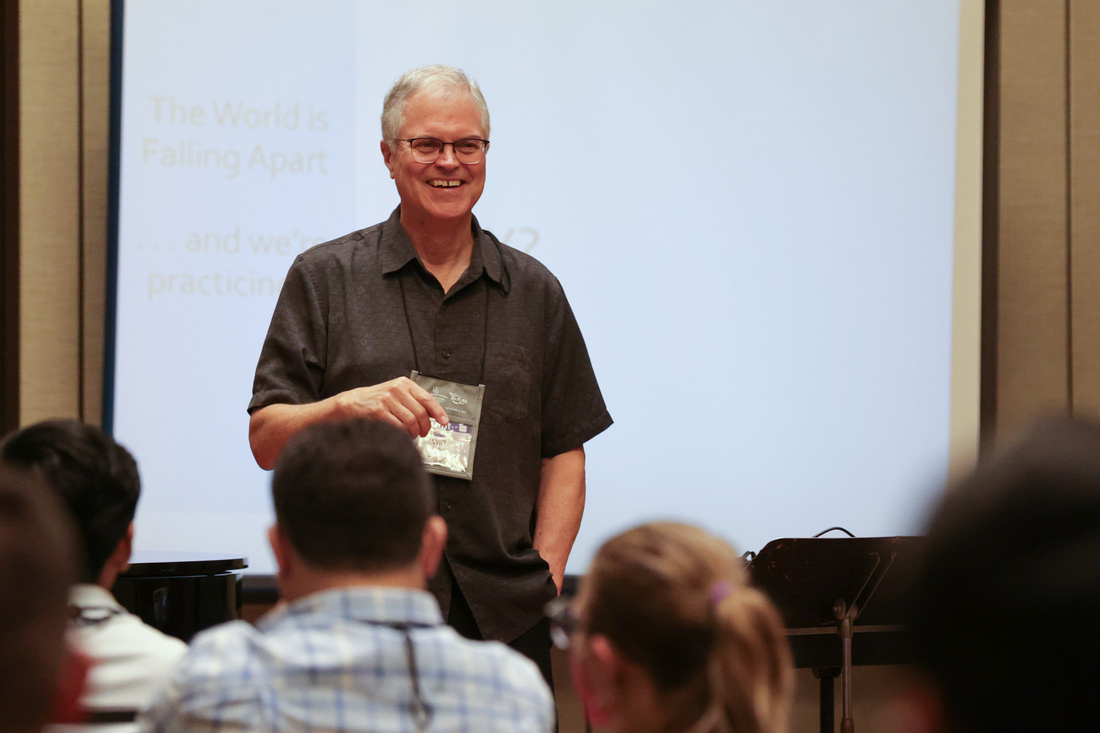

Jens Lindemann non-pro clinic - Expanding Range and Flexibility
Jens Lindemann began his clinic for non-professional/comeback players with a dazzling and energetic piccolo trumpet fanfare, aptly setting the tone for the remainder of this well-attended event. As Lindemann recanted some of his most influential and formative experiences with the trumpet, he also discussed many of the foundational ways in which he approaches the instrument. He discussed such topics as his personal practice routine, efficient tone production, approaches to articulation, connection to the instrument without added muscle tension, and many more. Throughout his discussion of pedagogy, Lindemann emphasized a philosophical message of intelligent practice, positivity, and perpetual curiosity. The audience was thoroughly engaged for the duration of the clinic and were encouraged to ask questions toward the end of the session. The resulting lively dialogue was enjoyed by all. Lindemann took a poignant moment to acknowledge the legacy of Ryan Anthony in his closing remarks. (Benjamin Hay)
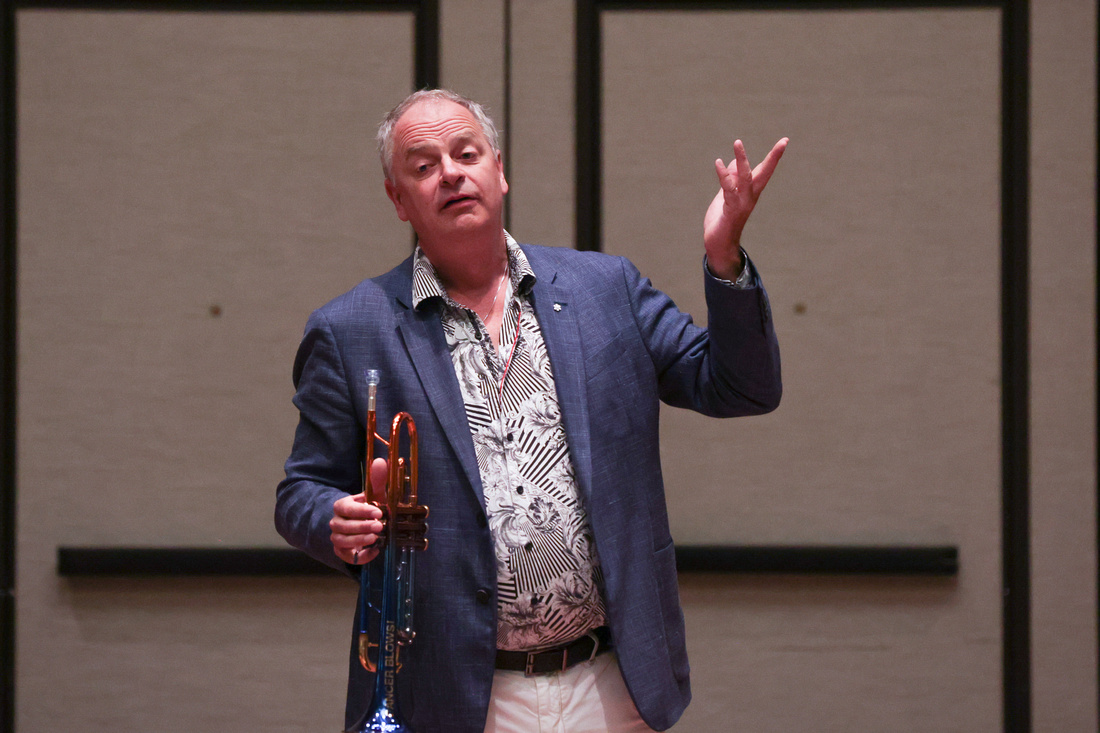

Wind Band Excerpts Competition Finals
In the Chula Vista Room, Susan Rider briefly introduced the Wind Band Excerpt competition finalists: Julia Gill, Christopher Keach, and Anna Kallinikos. The room had a welcoming aura, and there was a hearty round of applause for each finalist. Each competitor played a list of seven excerpts of varying difficulty, which tested their endurance, range, articulation, and interpretation. All three finalists handled the environment very well and, as expected, were extremely well prepared. The finalists’ teachers and friends were in attendance, and there was a great deal of socializing as everyone exited the room. (Nathan Shadix)
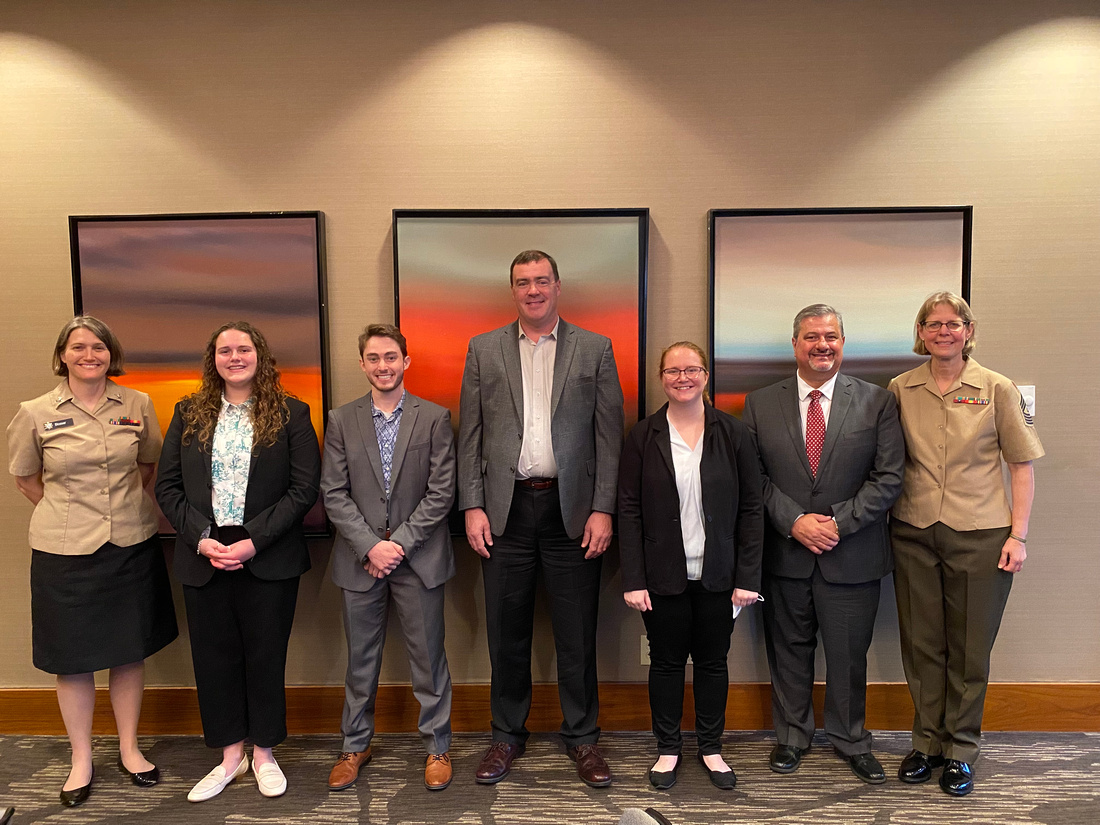

Elliot and Alejandra Johnston and Agustin Sandoval clinic - Introduction to Mariachi Trumpet Pedagogy and Style
With help from wonderful local mariachi musicians and willing ITG participants, the Johnstons, alongside Agustin Sandoval, gave a wonderful overview of mariachi pedagogy and style. This clinic involved helpful exercises for both students and professors wanting to learn more about the style. Using both Spanish and English to communicate to the attendees, they eloquently articulated the difference in use of vibrato and articulation between classical and mariachi styles. In a masterclass style, the team of leaders were able to display this extraordinarily effective teaching in the moment. Attendees were able to take home very helpful color-coordinated handouts to use in their own teaching and learning. Each attendee, whether a teacher, player, or lover of mariachi music, was sure to leave with something useful. (Brianne Borden)
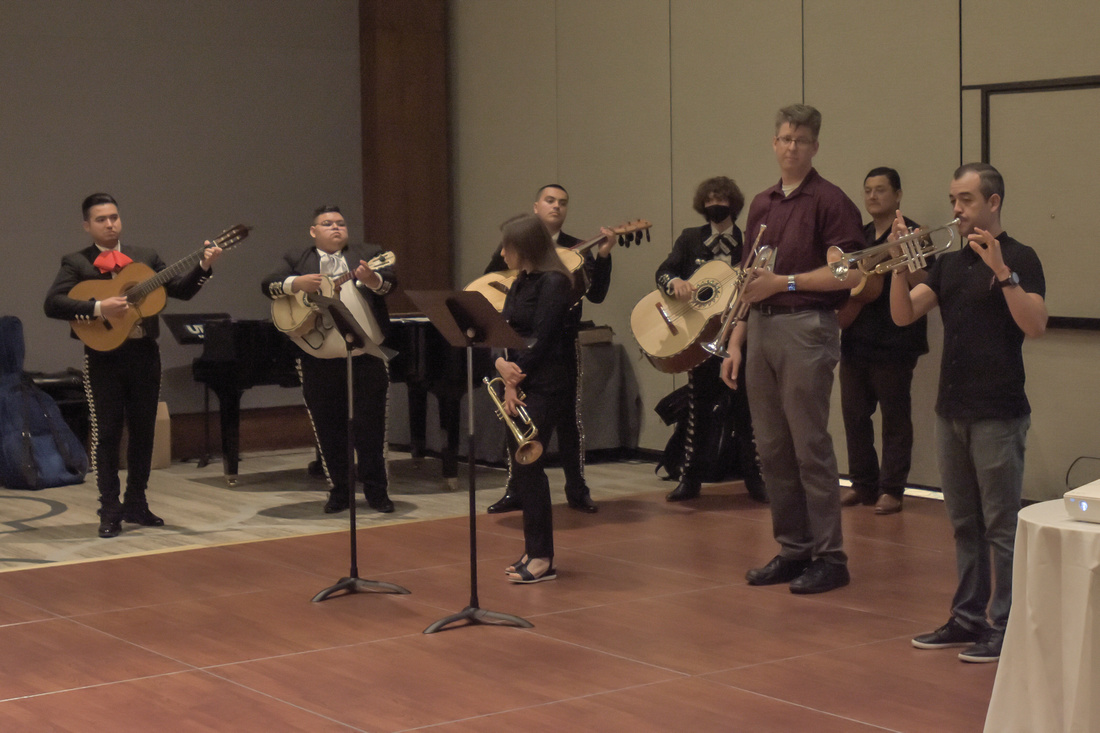

ITG Research Room
The ITG Research Room at this year’s Conference offered diverse presentations on three widely differing topics that represent unique focuses in scholarly research currently impacting the trumpet community. Dr. Nina Bausek and Angelica Aldarondo presented an in-depth presentation on the unique requirements of respiratory muscle training and its impact on a trumpet performer’s breath support and control. Dr. Elijah Denecke’s presentation highlighted many of the often-overlooked French works from the mid-twentieth century by women composers. His research highlighted three French female composers and key works within their corpus of repertoire that highlighted each of their unique compositional stylings. The final presentation examined the impact of the New York Brass Quintet’s influence on the development of chamber music during the mid- to late-twentieth century. Dr. James Sherry highlighted numerous significant chamber works and their historical impact that were premiered by this ensemble. (James Peyden Shelton)
New Works Recital I
The first of the New Works Recitals at this year’s Conference was composed entirely of works that were either unaccompanied or with accompaniment other than piano. The first work, Luis Engelke’s Voces Lucis et Tenebrae (Voices of Light and Darkness), was a prime example as it was written for trumpet and fixed media. The composer himself performed the work with projected visual scenes that evoked religious imagery and explored the contrasts between light and darkness in reference to the work’s title. Engelke performed with a shimmering, brilliant sound while still maintaining a relaxed resonance and consistent articulation. His character changes fit into the work’s exploration of musical chiaroscuro.
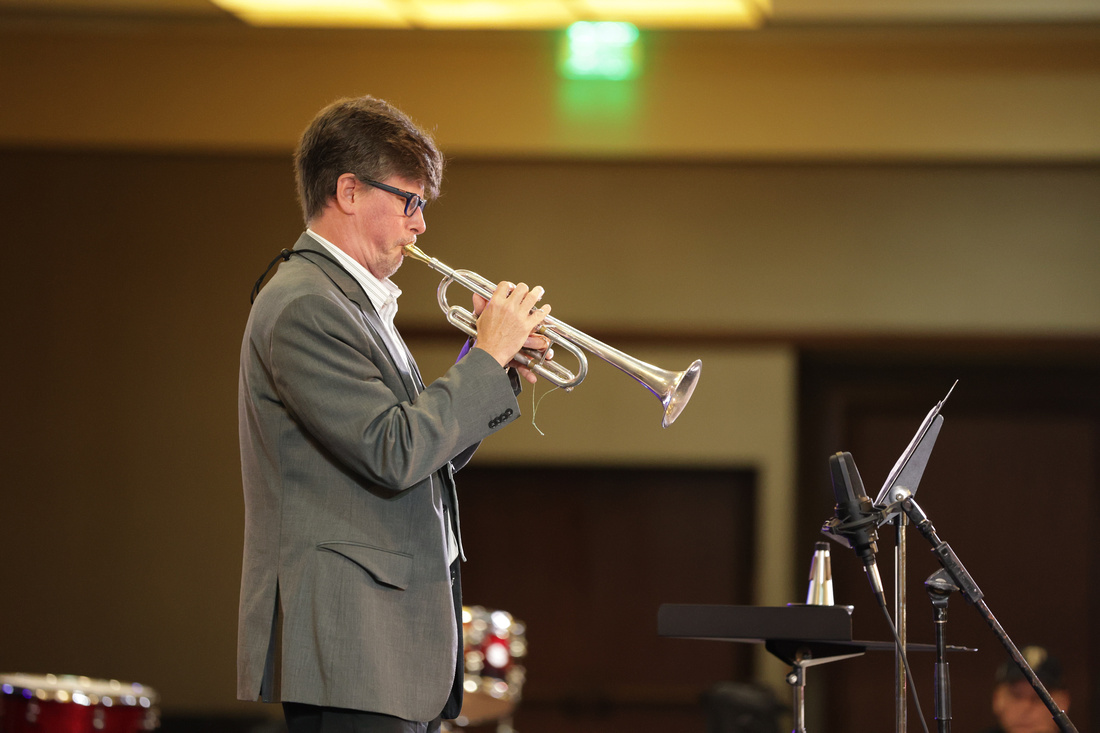

While the fixed-media accompaniment of Drew Tomasik’s Yearly Tech Review resembles the electronic music of public-access television in the late-twentieth century, trumpeter Stephen Campbell and hornist Gene Berger’s interpretation emphasized its newness and progressive use of electronic media in performance. Together, the performers were not simply accompanied by the media, but melded with it. The second movement, resembling LoFi music more than its neighboring movements, was especially notable as Berger stepped aside for Campbell’s radiant and pure tone to shine through.
TJ Perry’s performance of Now I am Become Death by Michael Cotton was incredibly moving. The work focuses on the emotional weight of nuclear warfare, with a ticking that resembles that of the doomsday clock. The media contains several recordings of powerful speeches, but most of it focuses on J. Robert Oppenheimer’s famous “Now I am become death” speech. While most of the trumpet part is angular amidst the spoken rhetoric of violence, the most prominent moment of lyrical expression is accompanied by John F. Kennedy’s Birmingham speech in which he stated, “We all breathe the same air, we all cherish our children’s future, and we are all mortal.” Perry’s performance enhanced the emotional weight of the source material, giving enough space for the media to come through without being overwhelmed by it. His pure tone soared through the room in a way that almost resembled Taps being played in the distance.
Jason Dovel’s rendition of his own unaccompanied work, Et Planetarum, was full of energy and excitement. While each movement is titled after a different planet, the work bears little resemblance to Holst’s similarly oriented orchestral suite. Dovel’s piccolo trumpet playing in the first movement, “Mercury,” was energetic and flashy while the second movement, “Venus,” was lyrical and reflective. By removing his second valve slide and using a Harmon mute, Dovel was able to achieve a playful effect in the third movement, “Mars.” Dovel’s performance explored the extremes of the instrument’s dynamic range, and the softer sections had the audience leaning closer to the stage.
Julia Bell’s performance of Jenna Veverka’s Solo Ascent demonstrated a level of conviction that was not only inspiring, but also educational for those who are afraid to approach unaccompanied repertoire. The work calls for wind effects at the beginning and middle of the performance. While this special effect can often sound contrived, Bell’s pacing left an air of mystique lingering through the hall. Every change of character came as a welcome surprise, and moments of pause were pregnant with anticipation. The fluidity throughout Bell’s entire range made a challenging piece sound effortless.
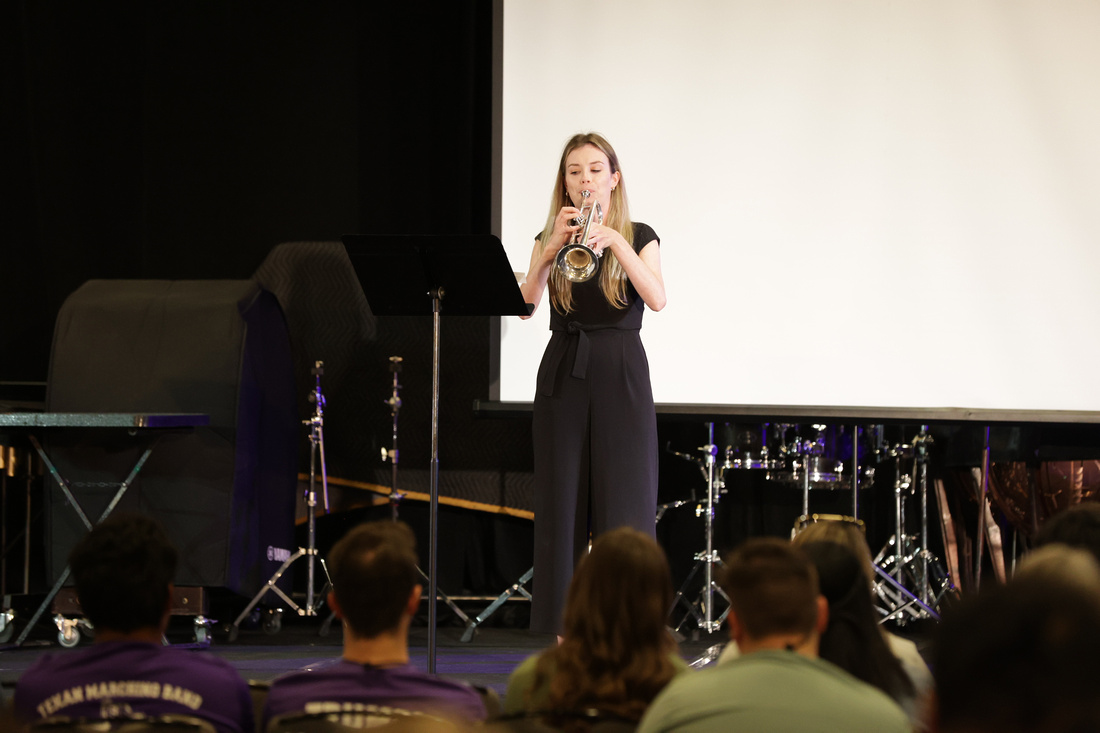

The three movements of Beth Wiemann’s It Floats Away from You, written for unaccompanied soprano and trumpet, are settings of three poems by Marianne Moore. Trumpeter Andrew Kozar and soprano Corrine Byrne provided a relaxing but engaging performance of the work. Kozar’s sound was rich and covered, allowing Byrne’s pure tone to dominate when necessary. While the phrases were shaped for an especially expressive interpretation of the work, the dynamic level remained relaxed throughout the entirety of the performance. (Christopher Luebke-Brown)
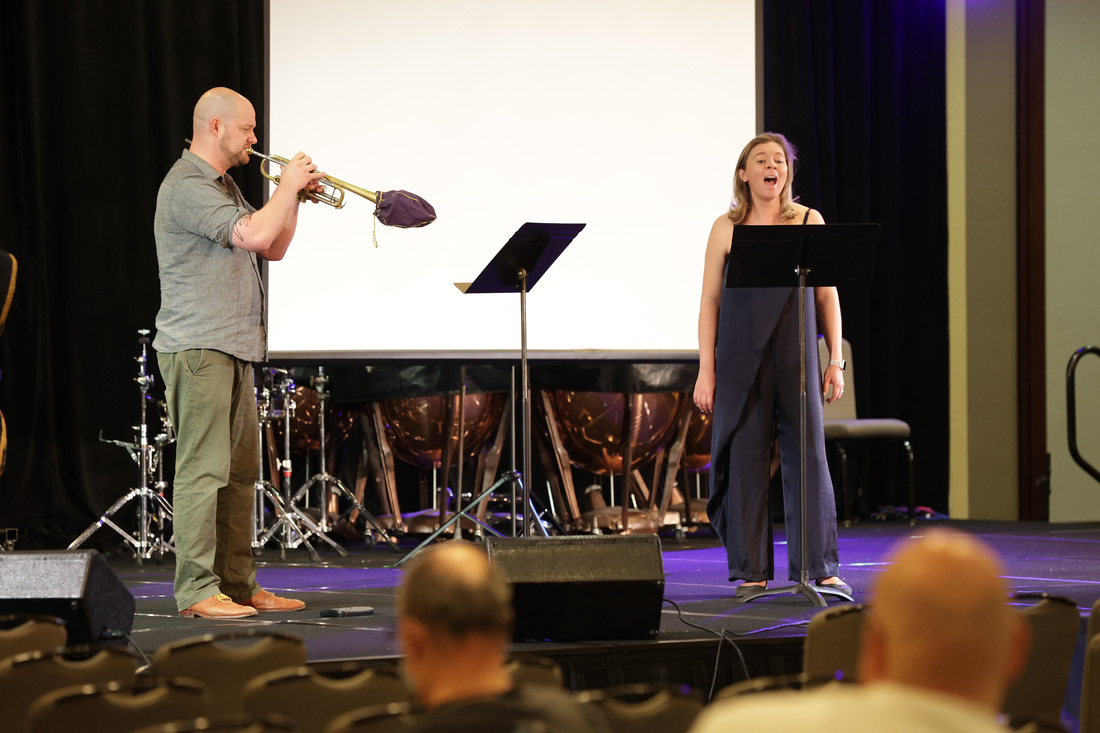

Michael Mergen clinic - A Guide to Cornet Articulation and “March Style”
Dr. Michael Mergen shared a detailed approach to performing in the march style with accurate cornet articulation. Many players are taught to play marches with a “light” and “short” articulation; however, as noted by Mergen, the overly short articulation can affect tone negatively. Additionally, performing a set of marches presents its own physical challenges. From revisiting Arban’s writing, studying different bowing techniques, and recalling his conversations with clarinetists (with whom the cornet typically doubles in marches), Mergen advocates for a longer articulation that mimics the movement of a violin bow. He specifically addresses each type of articulation and how it could be performed in context, resulting in improved style, phrase shape, ease of playing, and beauty of sound. Based on his years of experience performing in “The President’s Own” United States Marine Band, Mergen’s lecture provided new insight and information on performing in the march style on cornet. (Spencer Brand)


Joey Tartell recital - 7 Horns in 60 Minutes
Joey Tartell proved his widely acclaimed versatility, musicianship, and virtuosity with his “7 Horns in 60 Minutes” recital performance. Tartell transitioned between each instrument seamlessly, performing this ambitious and artfully conceived program with nuance and finesse. He began with Turrin’s Escapade on piccolo trumpet, followed by the beautiful, quirky, and challenging Sonata by George Antheil. The unquestionably masterful balance and musical dialogue between Rebecca Wilt’s piano and Tartell’s trumpet, which marked the entire performance, were on full display during Antheil’s Sonata. The next two lovely and relatively obscure pieces (Korngold’s Marietta’s Lied and Longinotti’s Badinerie) were performed on E-flat and C trumpet respectively. The world premiere of William Stowman’s Suite for B-flat Trumpet, Flugelhorn, and Bass Trumpet featured near-seamless transitions between each instrument and inspired writing throughout. Peaslee’s popular Nightsongs (flugelhorn and B-flat trumpet) and Philip Sparke’s Song and Dance (cornet) concluded the program. (Benjamin Hay)
Chloe Swindler lecture recital - Five Works for Trumpet by Black Female Composers
International award-winning soloist Chloe Swindler presented an enlightening session illuminated five works for trumpet by Black female composers. Swindler began by describing the aesthetic qualities of Black American music, such as contrasting timbre, improvisation, and several others. Accompanied by accomplished pianist Miriam Hickman, Swindler performed a program of works by Regina Harris Baiocchi, Mary Watkins, Alice Jones, and Florence Price in the second segment of the clinic. Swindler’s warm tone and highly-skilled playing resulted in stunning performances of these challenging works. In her final remarks, she discussed ways to contribute to a more inclusive and diverse world of trumpet repertoire - accessing Black female composer’s scores, creating recordings of the works, incorporating them into music curricula, and introducing them to new audiences. Swindler’s session provided insightful information regarding the available music by Black American female composers and its importance in trumpet repertoire. (Sarah Cisney)
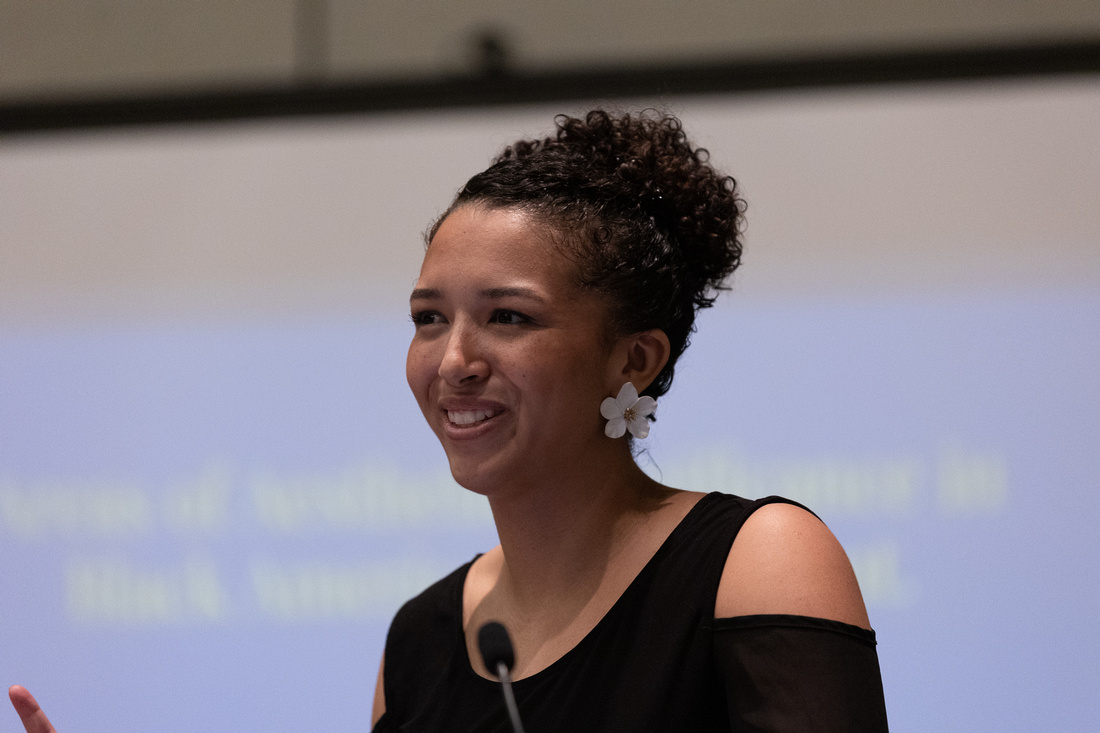

Sebastián Gil Armas recital - Works for Trumpet and Organ by Edward Tarr Series
This recital consisted of music that Sebastián Gil Armas prepared in honor of Edward Tarr. Accompanied by organist Bryan Anderson at the Travis Park Church, the pair performed exceptionally. The recital opened with three short sonatas by Girolamo Fantini, performed on natural trumpet. Armas’s tone oscillated between sweet and brilliant, and his attention to phrasing and color was evident in each piece of the program. Of particular note was Armas’s flugelhorn playing on several of the pieces; his sound blended seamlessly with the organ in a way that demonstrated his superb sensitivity to balance and timbre. This varied program was met with hearty applause from the audience and a renewed appreciation for Edward Tarr’s tireless commitment to the trumpet. (Eli Denecke)
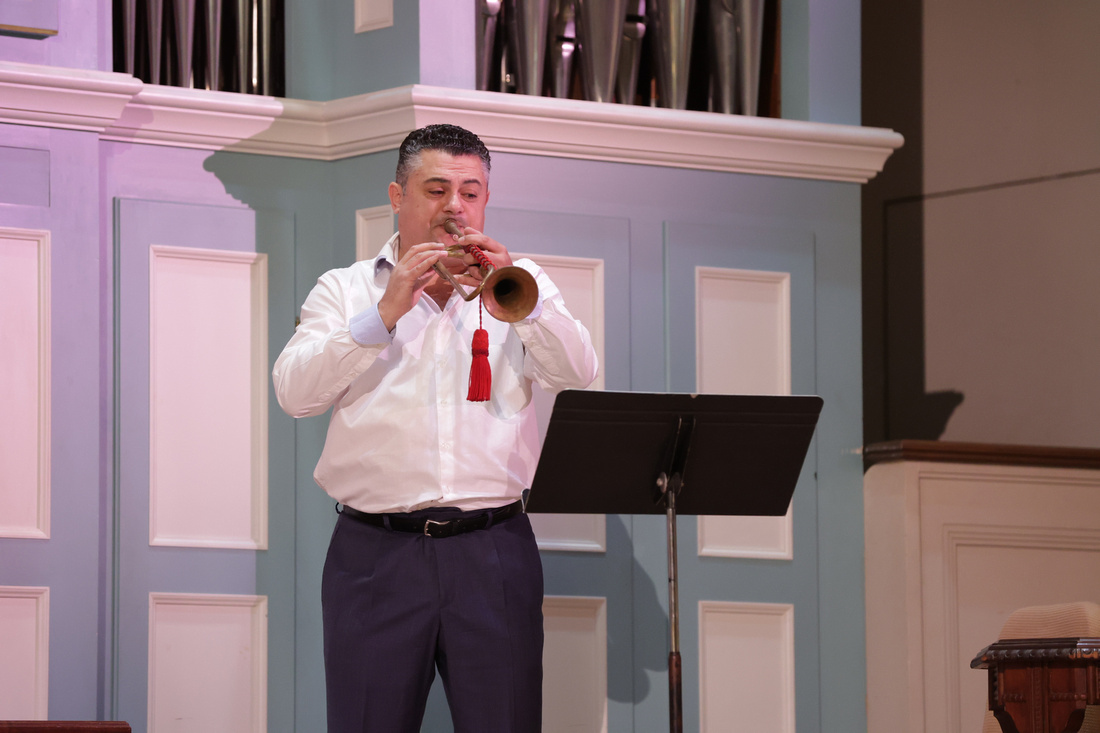

David Bilger clinic - The Orchestra Job: Everything Except the High C
David Bilger began the session by discussing a few prepared remarks touching on some of the important nuts and bolts of the job of an orchestral trumpet player - like how The Philadelphia Orchestra handles part assignments and their process for recent sublist auditions - before moving on to field questions from the audience. He answered many questions on a variety of topics that included the tenure process in orchestras, audition preparation, current trends in trumpet teaching, and characteristics of the best section players. He mentioned more than once the importance of developing the basics of trumpet playing - tone, intonation, and rhythm - and also drove home the importance of staying dedicated to the craft of practicing and preparation. He mentioned that in order to continue growing and advancing as a trumpet player, developing a daily routine and enjoying the mundane aspects of trumpet fundamentals can help players avoid common pitfalls. (Scott Hagarty)
Carrie Blosser clinic - Successful Starts: A Guide to the First Six Months for Beginning Trumpet Players
Dr. Carrie Blosser’s clinic featured numerous tips and tricks to help young students thrive. Blosser offered tips for teaching such basics as breathing, buzzing, and holding the instrument. When teaching the first sounds on the mouthpiece and instrument, she discussed the importance of creating a positive environment. Blosser also had numerous tips for troubleshooting issues with embouchure, air flow, and articulation. One unique tactic she calls “kazoo trumpet,” in which the mouthpiece is held slightly out of the receiver while playing, helps center the sound. Blosser’s approach also included visual aids and relatable examples such as movies and video games the student might enjoy. Throughout the presentation, Blosser emphasized the importance of including and encouraging students from all backgrounds by showing them videos featuring diverse performers playing exciting repertoire. (Marisa Youngs)
Spencer Wallin clinic - Suona la Tromba: Exploring the Performance and Technique of the Baroque Trumpet Aria
Dr. Spencer Wallin’s lecture recital on performance techniques of the Baroque trumpet aria was a refreshing change of pace as he provided insights and tips on performing and teaching Baroque music. Many of Wallin’s suggestions were informed by his personal experience in performing and teaching this music. Collaborators Rachel Wallin (piano) and Margaret Wolfe (soprano) added additional insights into the collaborative process - how trumpet players can be more sensitive to collaborative vocalists and how we can approach this music with a sensitivity that allows the musical interpretation to come through? Additionally, Wallin recommended several early-Baroque trumpet arias (works by Pallavicino, Legrenzi, and Handel) to help young students approach the genre in a way that can lead to success. (Joe Nibley)
Jazz Improvisation Competition Finals
The final round of the jazz improvisation competition featured three outstanding soloists performing for an intimate, yet enthusiastic, audience. In addition to the required tune, Punjab, each contestant included two tunes in their set. Camilo Molina (University of Miami) performed a crisp Up Jumped Spring and Sound of Love; Emerson Borg (UNC Greensboro) performed Evidence and Shame is Pride’s Cloak; and Summer Camargo (The Juilliard School) performed When It’s Sleepy Time Down South and JP Shuffle - the latter an original that she wrote for her father who was in attendance. Adjudication duties were handled by Bria Skonberg, Philip Dizack, and Ansyn Banks. The soloists were backed by a very tight rhythm section of Mike Frank on piano, Peter Paulsen on bass, and Larry Marshall on drums. (Daniel Kelly)
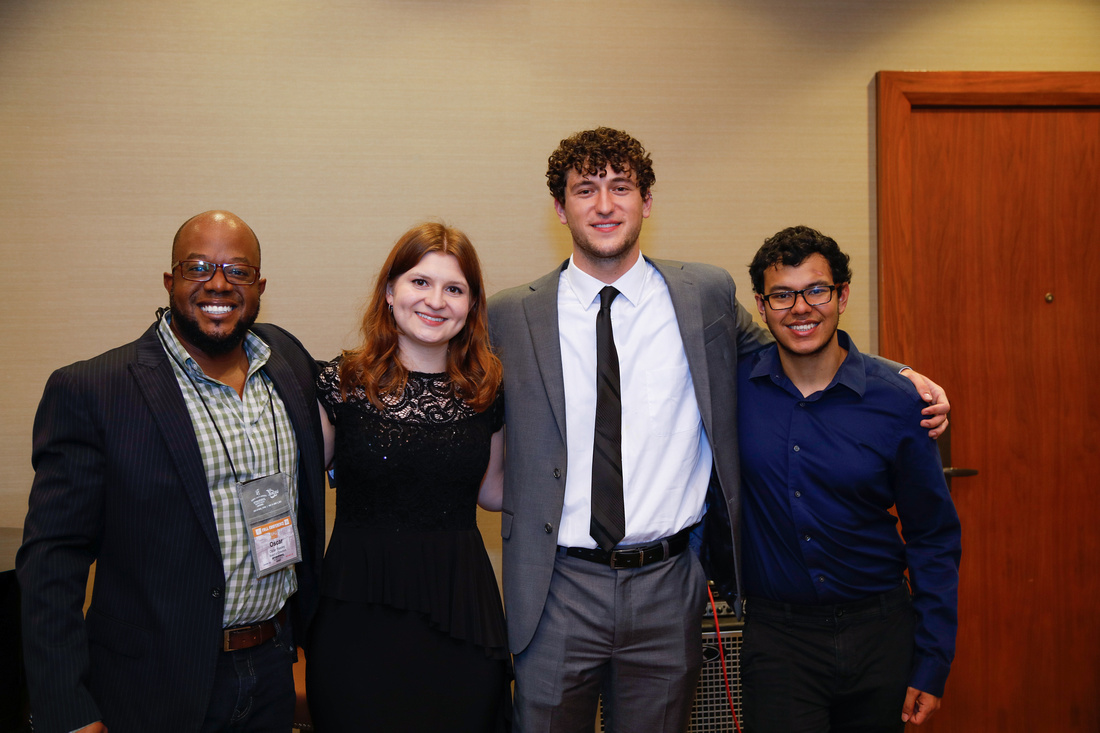
 Female and Non-Binary Identifying Trumpet Summit
Female and Non-Binary Identifying Trumpet Summit
Renowned jazz trumpeter and passionate educator Bria Skonberg led an engaging and empowering summit for female and non-binary trumpet players. Through small- and full-group discussions, attendees shared musical memories of empowerment and discouragement and addressed challenges unique to female and non-binary trumpeters. International award-winning soloist Chloe Swindler voiced her experience as a Black woman in the trumpet community, which resulted in discussion about ways to create spaces in music for both female/non-binary people and people of color. The session closed with advice for young trumpeters from the older generation of female and non-binary players. Skonberg’s meeting was encouraging for all ages and skill levels and provided optimism for continued growth, opportunities, and representation for female and non-binary trumpeters. (Sarah Cisney)
Reception: Non-Pro and Comeback Players
The Non-Pro and Comeback Players meet-and-greet reception was well-attended with participants from all over the United States and Canada. Attendees were introduced to the Non-Pro Players Committee, ITG President Jason Bergman, and President-Elect Ryan Gardner, as well as several ITG past presidents and special guests Jens Lindemann and Ole Edvard Antonsen. For the first time in three years, members of the Non-Pro and Comeback Player community were able to reconnect in person, sharing stories of their travels and the most anticipated events on their ITG Conference itineraries. Attendees were able to discuss and coordinate their attendance at the remaining Non-Pro Player events. (Julia Bell)
Evening Concert - Monarch Brass
The Wednesday evening concert opened with a dramatic, angular fanfare by Kathryn Salfelder entitled Prospect Hill: Flourish for Brass, which showcased the intervallic virtuosity of the Monarch Brass Ensemble, under the direction of Maj. Michelle Rakers (USMC-retired). The fanfare segued into Daniel Drage’s arrangement of the beautiful Holberg Suite, originally composed by Edvard Grieg. This work provided moments for individual sections to be in the spotlight as each movement utilized a unique combination of color and style. The full ensemble then left the stage, giving way to a trumpet ensemble that performed Susan Slaughter’s arrangement of Amazing Grace with Slaughter conducting. Each phrase allowed for a new soloist to present their own beautiful timbre and grace through this traditional melody. The ensemble then rejoined the trumpeters on stage to present Samuel Barber’s Mutations from Bach. This piece once again highlighted the impeccable artistry that each performer and section harnessed. Barber’s work presented the unaltered melody in the opening and then allowed it to mutate and twist throughout the entire piece. The ensemble again quickly left the stage, leaving only a duo of one euphonium and tuba to perform Bach’s wonderful Two Part Invention No. 4, arranged by Chris Sharp. This uniquely fun and jazzy duet allowed the low brass to have an uplifting and joyful moment in the spotlight that helped cleanse the palette for the final pieces of the concert. Paola Prestini’s Wave began with haunting sounds of wind and muted low-brass drones that were counterpointed with hushed high-brass chord clusters. This dichotomy of sounds and motifs then began to layer and build upon one another, bringing a unique blend and balance of timbres was enhanced by the sheer power that only a full brass ensemble of this caliber can provide. The concert closed with an epic composition by film composer Bruce Broughton. His Fanfares, Marches, Hymns, & Finale truly showcased the virtuosic power and subtle diverse timbres of the mighty Monarch Brass. Each movement provided the audience with a new aural landscape that gave way to emerging soloists and section features that intertwined through acrobatic fanfares and powerful brass sonorities. Broughton’s composition truly allowed the ensemble to showcase their power, virtuosity, diversity in color, and ensemble precision that undoubtedly marks their position as one of the top brass ensembles in the world.
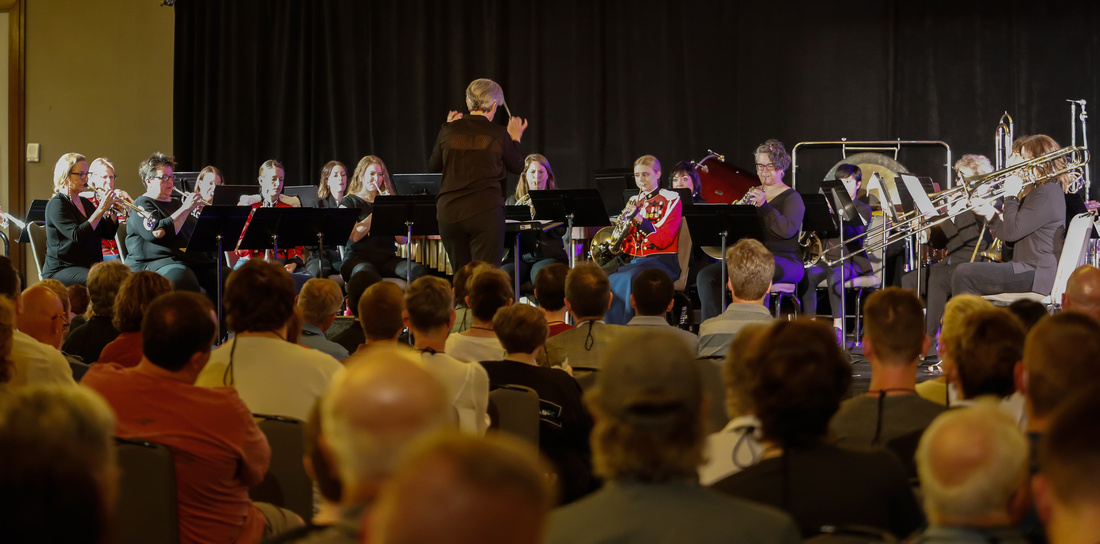

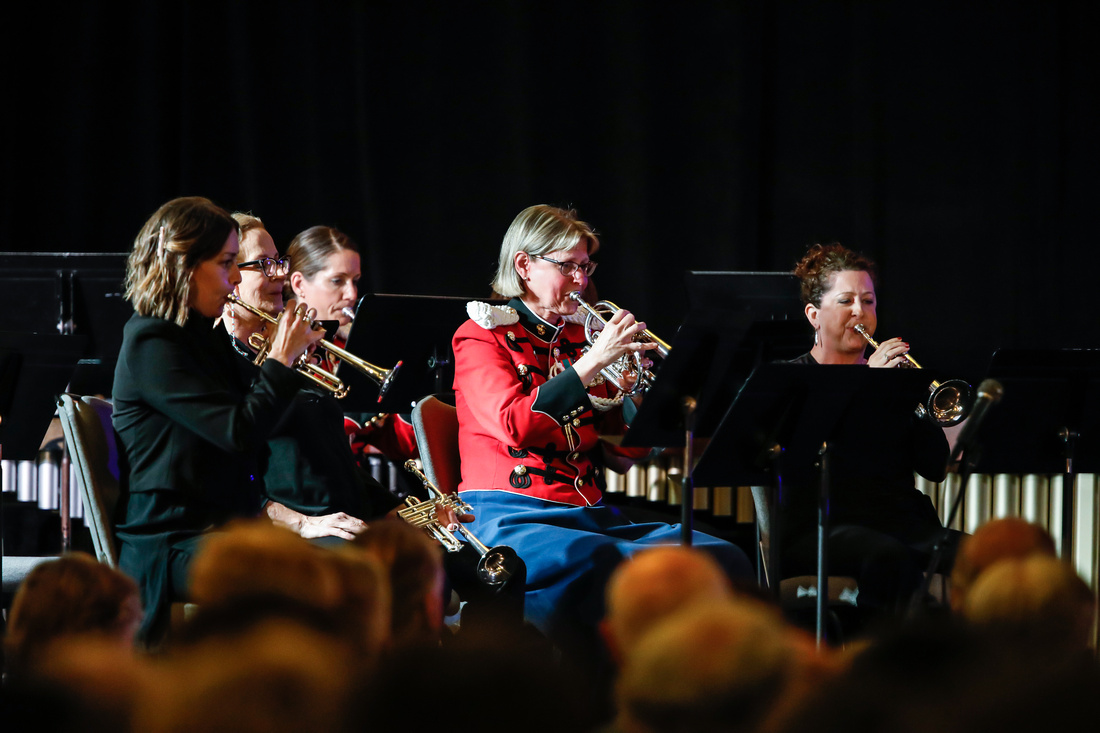

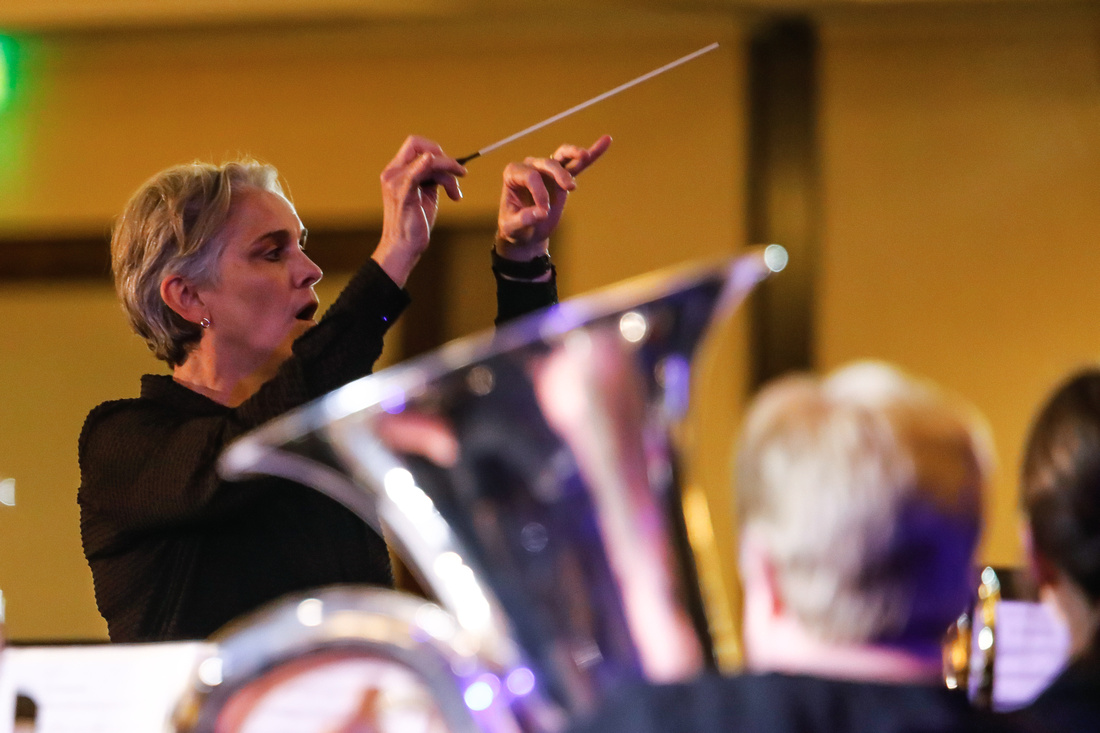

Also during this program, ITG President Jason Bergman presented Carole Dawn Reinhart with the ITG Honorary Award and presented the winners of the jazz improvisation and wind band excerpts competitions. (James Peyden Shelton)
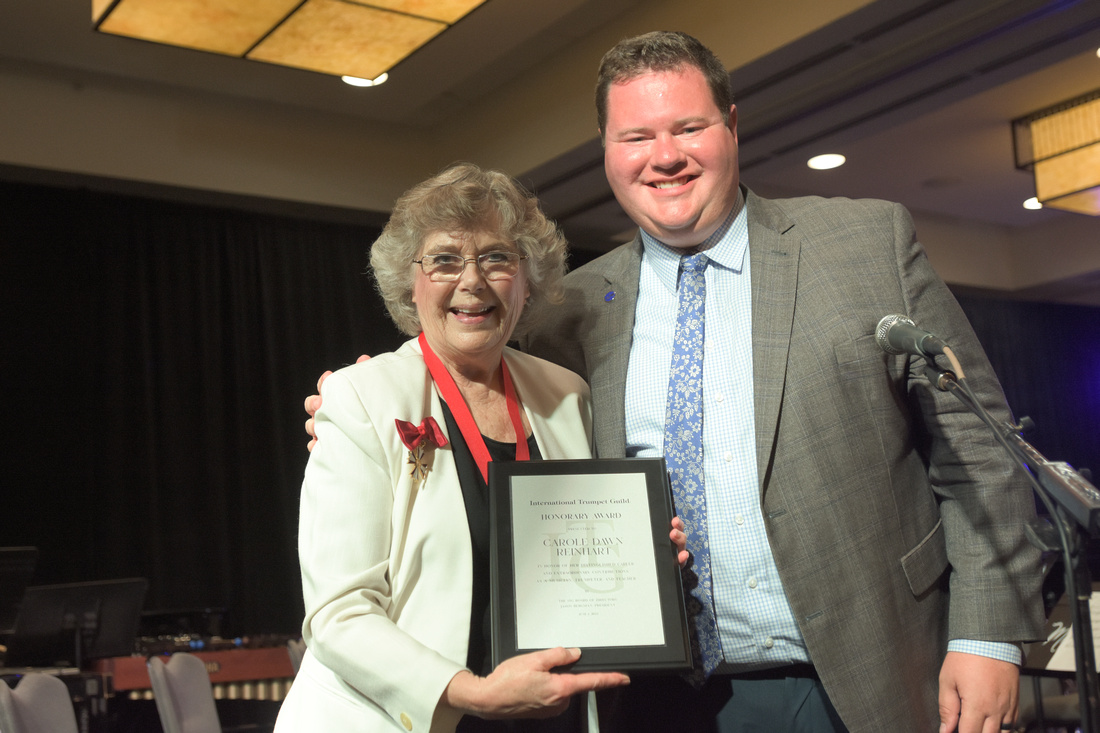

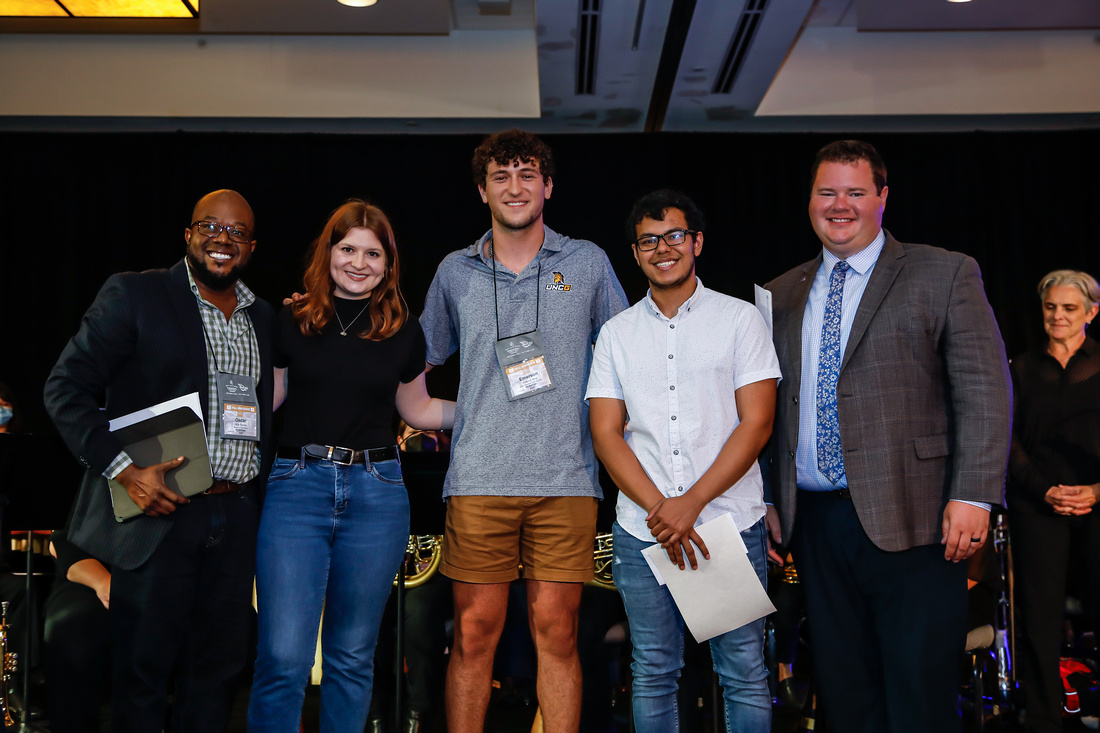

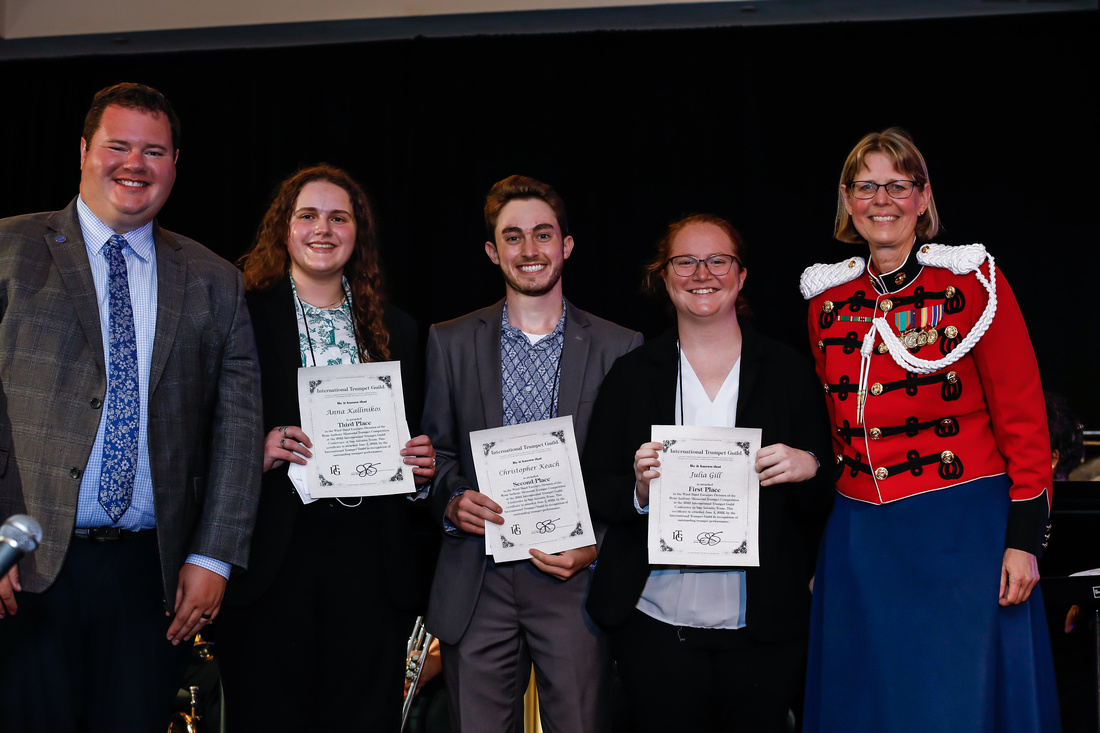

Jam Session - Eric Siereveld
Eric Siereveld hosted a late-night jazz jam session featuring Mike Frank on piano, Peter Paulsen on bass, and Larry Marshall on drums. Siereveld opened the session by performing a jazz tune to warm up the audience, featuring solos from each member of the rhythm section, who displayed their mastery of improvisation. Siereveld certainly displayed musical brilliance and beautiful sound in the opening tune. Following that, members of the audience signed up to perform a tune of choice with the rhythm section. There were trumpet players of all ages and experience levels playing various jazz standards, making the jam a unique experience. Throughout the night, each performer excelled, which made the session a great event not just for the performers, but for the audience as well. (Javian Brabham)
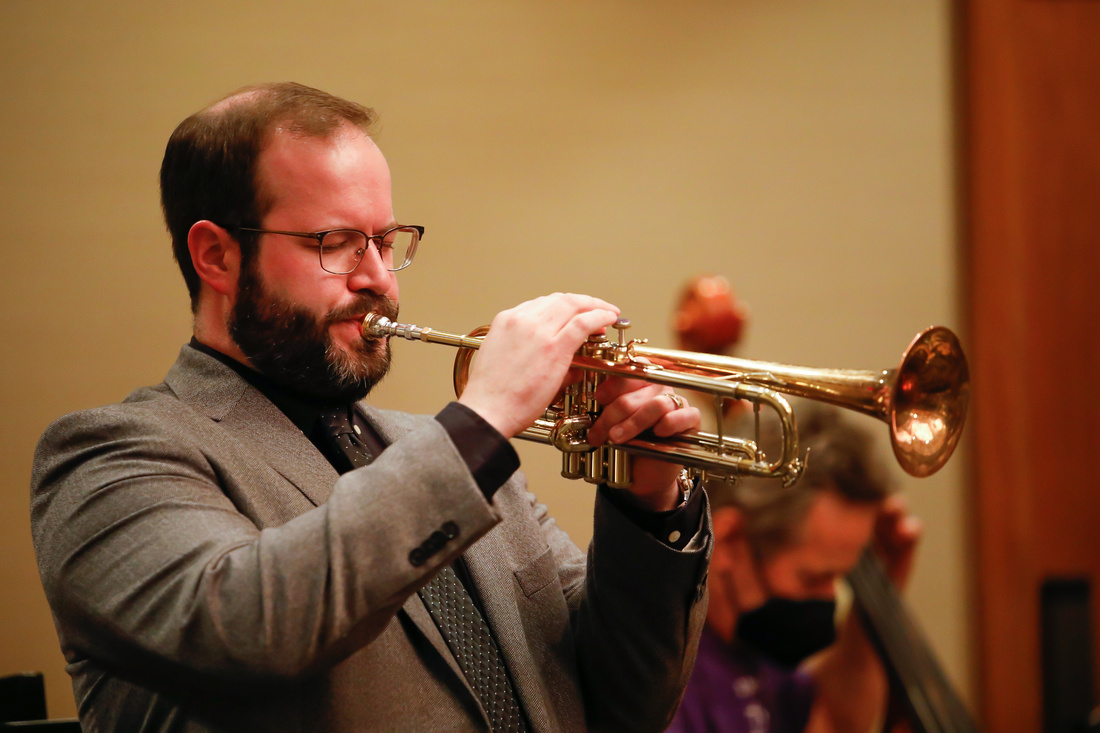

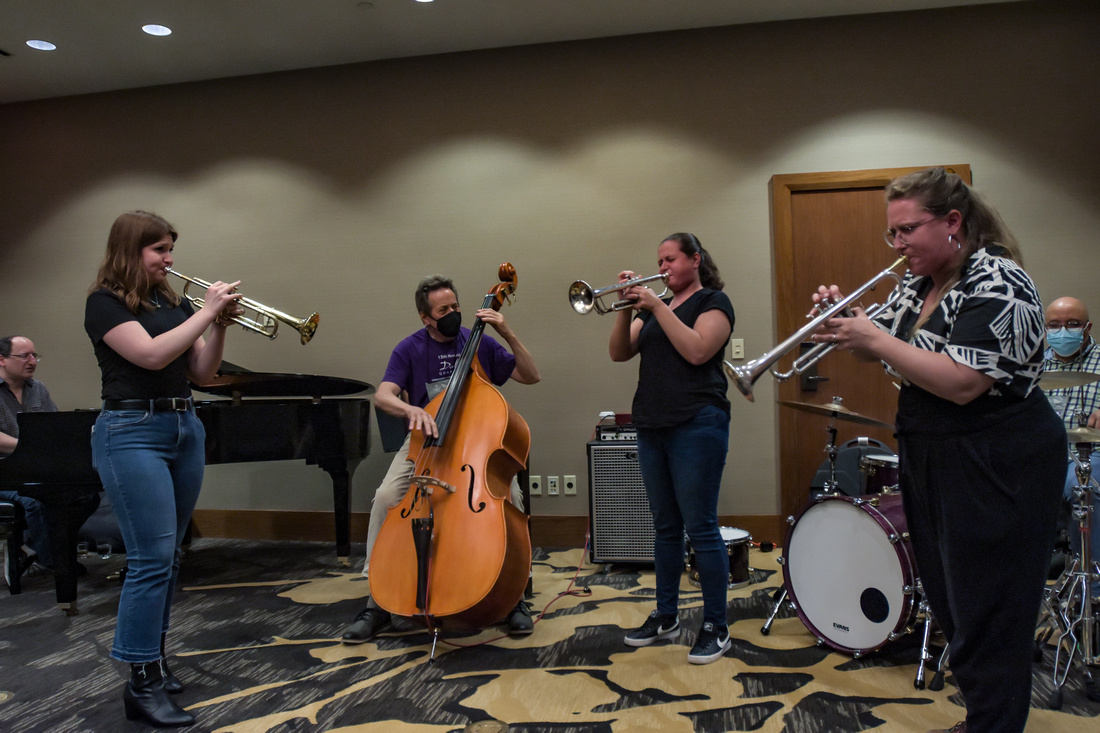

Click here for more photos from the ITG Conference